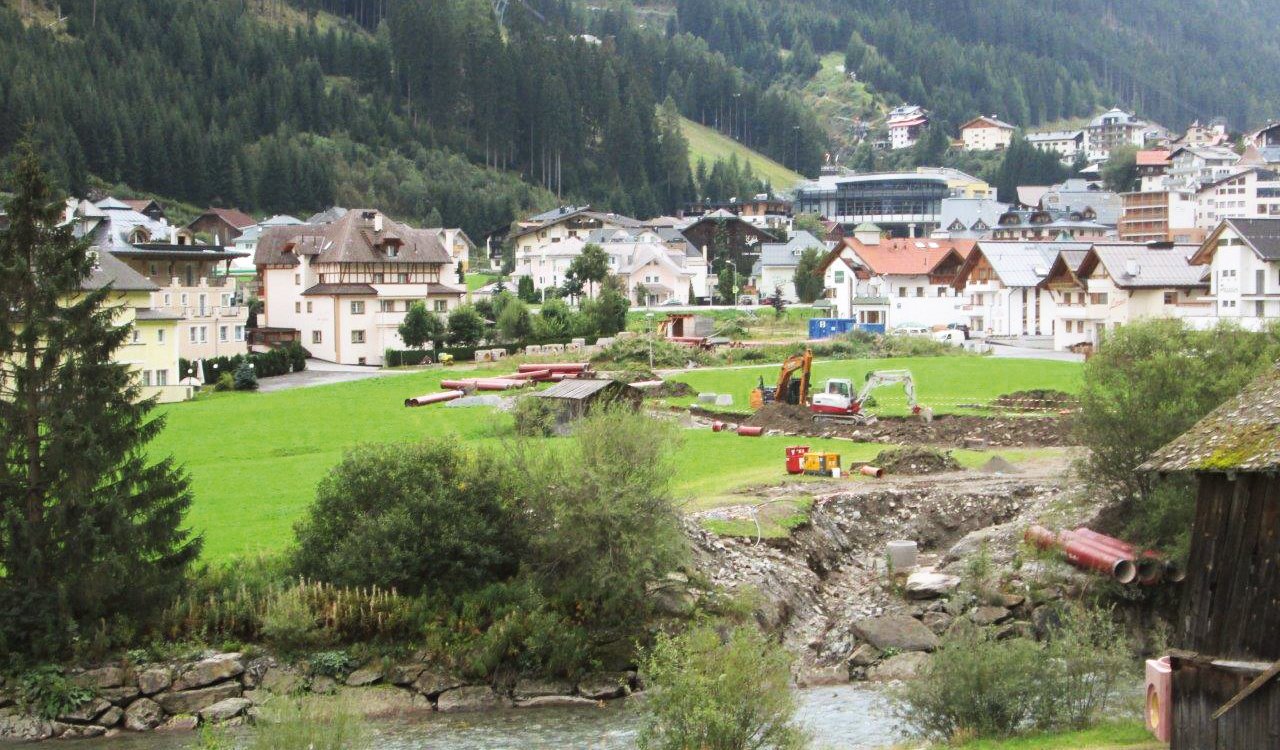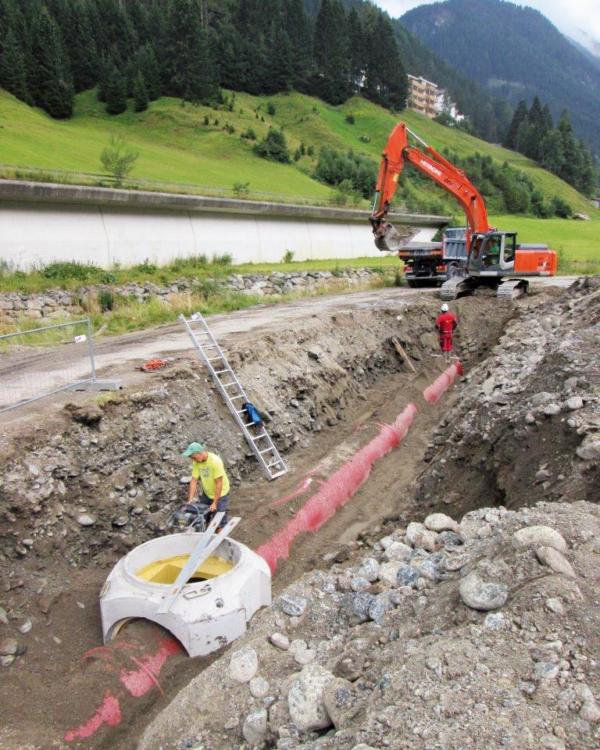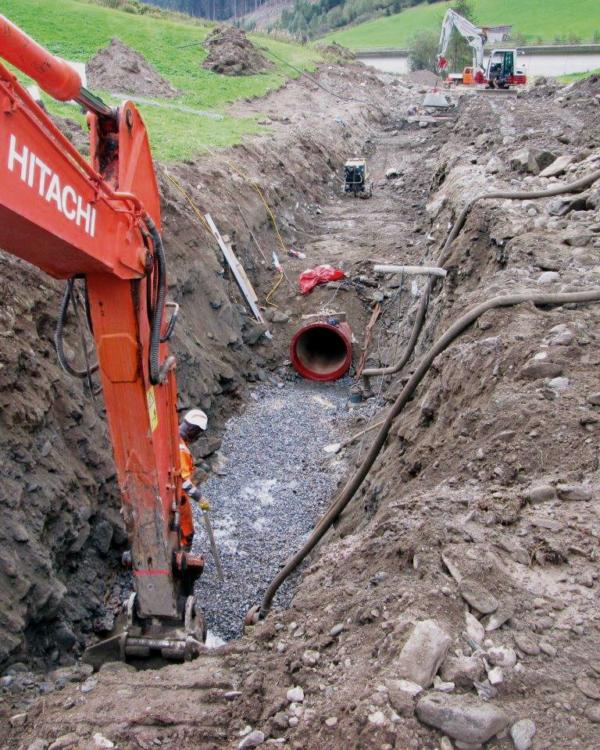Hydraulische Sanierung des Abwassersystems in Ischgl
Ischgl boomt und das bereits seit der Eröffnung der Silvretta-Seilbahn im Jahre 1963, damals war sie die längste Gondelbahn Österreichs. Schon nach vier Jahren kamen 100.000 Winterurlauber. Die touristische Wachstumsspirale drehte sich in Ischgl rasant. Bereits 1976 hatte die Gemeinde die höchste Auslastung unter allen Wintersportgebieten in Österreich erreicht. Heute sind knapp 10.500 Gästebetten, fast sieben auf jeden der 1.539 Einheimischen, in der Wintersaison von Oktober bis Anfang Mai an hundert Tagen belegt. Damit Ischgl auch in Zukunft eines der begehrtesten Winterurlaubsziele Tirols bleibt, muss sich mit der touristischen Entwicklung auch die örtliche Infrastruktur weiterentwickeln. Hierzu gehört auch die Kanalisation.

Verlauf der Rohrtrasse am Ortsrand von Ischgl
Kanalnetz war hydraulisch und baulich sanierungsbedürftig
Bereits seit längerer Zeit, aber spätestens seit dem Jahrhunderthochwasser 2005, weiß man, dass das Kanalnetz der Gemeinde und des Abwasserverbandes Oberpaznaun vom Regenüberlaufbecken Versahl bis zum Ortsteil Schmittaboden schadhaft ist. In den vergangenen Jahren kam es bei Starkregen zu hydraulischen Überlastungen, die einerseits durch die vermehrte Bautätigkeit in Ischgl und die damit verbundene starke Zunahme des Versiegelungsgrades ausgelöst wurden. Andererseits bewirkte der teilweise desolate Zustand einzelner Abschnitte die Verminderung der hydraulischen Leistungsfähigkeit. Da sich von 1978 bis 2013 der Versiegelungsgrad und die Einzugsflächen geändert hatten und außerdem ein neues Raumordnungskonzept vorlag, entschloss sich die Gemeinde Ischgl im Jahre 2013 zu einer hydraulischen Überrechnung des gesamten Kanalnetzes und darauf aufbauend zur baulichen und hydraulischen Sanierung des Netzes.
Erneuerung in zwei Schritten
Aus finanziellen Gründen entschied sich die Gemeinde zunächst dafür, in einem ersten Bauabschnitt das Abwassernetz von Schmittaboden bis zur Versahler Brücke zu sanieren. Der Verbandssammler vom Weiler Schmittaboden bis zum Regenüberlaufbecken Versahl, der eine Länge ca. 1.600 lfm hat, wies große bauliche Schäden auf. Der Kanal war auf einer Länge von ca. 400 m sehr tief verlegt, teilweise mit Schachttiefen bis zu 7 m. Die Kanalrohrsohle war durchgeschliffen, die Schächte wiesen zahlreiche faustgroße Löcher auf und waren undicht. Fremdwasser drang ein, was zu einer zusätzlichen hydraulischen Belastung des Mischwasserkanals beitrug. Die Klinkerziegel in den Schachtsohlen waren teilweise ausgebrochen und weggespült. In diesem Abschnitt der Ortsentwässerung von Ischgl waren außerdem noch zwei Regenüberläufe vorhanden, die nicht mehr dem Stand der Technik entsprachen und gemäß Wasserrechtsgesetz angepasst werden mussten. Mit der Sanierungsplanung und Bauüberwachung wurde das Ingenieurbüro Walch & Plangger beauftragt.
Erneuerung bei großen Einbautiefen im Grundwasser
Die umfangreiche Sanierung umfasste eine Erneuerung von ca. 1.211 Meter Mischwasserkanälen mit Rohren im Durchmesserbereich von DN 250 bis DN 1000. Die Projektgebiete befinden sich fast durchwegs im alpinen Bereich. Alleine daraus resultierten hohe Anforderungen an das zu wählende Rohrsystem. Verstärkt wurde dies durch die Lage der Rohre in einer Tiefe von bis zu 7,00 m mit anstehendem Grundwasser. Zur Anwendung kamen deswegen auf einer Länge von 800 m gegenüber Infiltrationen dichte Rohre aus duktilem Gusseisen von TRM (Tiroler Rohre GmbH) nach EN 598.

Verfüllen des Leitungsgrabens nach dem Einbau der Schächte und der fremdwasserdichten Rohre

Einbau der duktilen Gussrohre in einem Bereich mit anstehendem Grundwasser
Abwasserrohre nach EN 598 sind fremdwasserdicht
Der Nachweis der Dichtheit von Steckmuffen-Verbindungen von Rohren nach EN 598 gegenüber infiltrierendem Grundwasser (Fremdwasser) wird bereits im Rahmen der nach Norm obligatorischen Funktionsprüfungen durchgeführt. Für die Prüfungen werden Steckmuffen-Verbindungen mit einem maximalen Ringspalt ausgewählt und dann auf zwei verschiedene Arten hinsichtlich Ihrer Dichtheit gegenüber Infiltration geprüft. Zum einen werden die Verbindungen mit einem positiven hydrostatischen Außendruck von 2 bar (20 Meter Wassersäule) und zum anderen mit einem negativen Innendruck (Vakuum-Prüfung) von 0,9 bar jeweils über die Dauer von 2 h geprüft. Auf diese Art wird sichergestellt, dass über die Steckmuffen-Verbindungen duktiler Gussrohre auch unter extremen Bedingungen kein Grundwasser eindringen kann.
